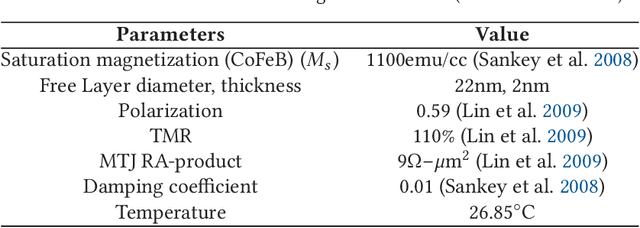Supriyo Datta
Composable Probabilistic Inference Networks Using MRAM-based Stochastic Neurons
Nov 28, 2018



Abstract:Magnetoresistive random access memory (MRAM) technologies with thermally unstable nanomagnets are leveraged to develop an intrinsic stochastic neuron as a building block for restricted Boltzmann machines (RBMs) to form deep belief networks (DBNs). The embedded MRAM-based neuron is modeled using precise physics equations. The simulation results exhibit the desired sigmoidal relation between the input voltages and probability of the output state. A probabilistic inference network simulator (PIN-Sim) is developed to realize a circuit-level model of an RBM utilizing resistive crossbar arrays along with differential amplifiers to implement the positive and negative weight values. The PIN-Sim is composed of five main blocks to train a DBN, evaluate its accuracy, and measure its power consumption. The MNIST dataset is leveraged to investigate the energy and accuracy tradeoffs of seven distinct network topologies in SPICE using the 14nm HP-FinFET technology library with the nominal voltage of 0.8V, in which an MRAM-based neuron is used as the activation function. The software and hardware level simulations indicate that a $784\times200\times10$ topology can achieve less than 5% error rates with $\sim400 pJ$ energy consumption. The error rates can be reduced to 2.5% by using a $784\times500\times500\times500\times10$ DBN at the cost of $\sim10\times$ higher energy consumption and significant area overhead. Finally, the effects of specific hardware-level parameters on power dissipation and accuracy tradeoffs are identified via the developed PIN-Sim framework.
 Add to Chrome
Add to Chrome Add to Firefox
Add to Firefox Add to Edge
Add to Edge